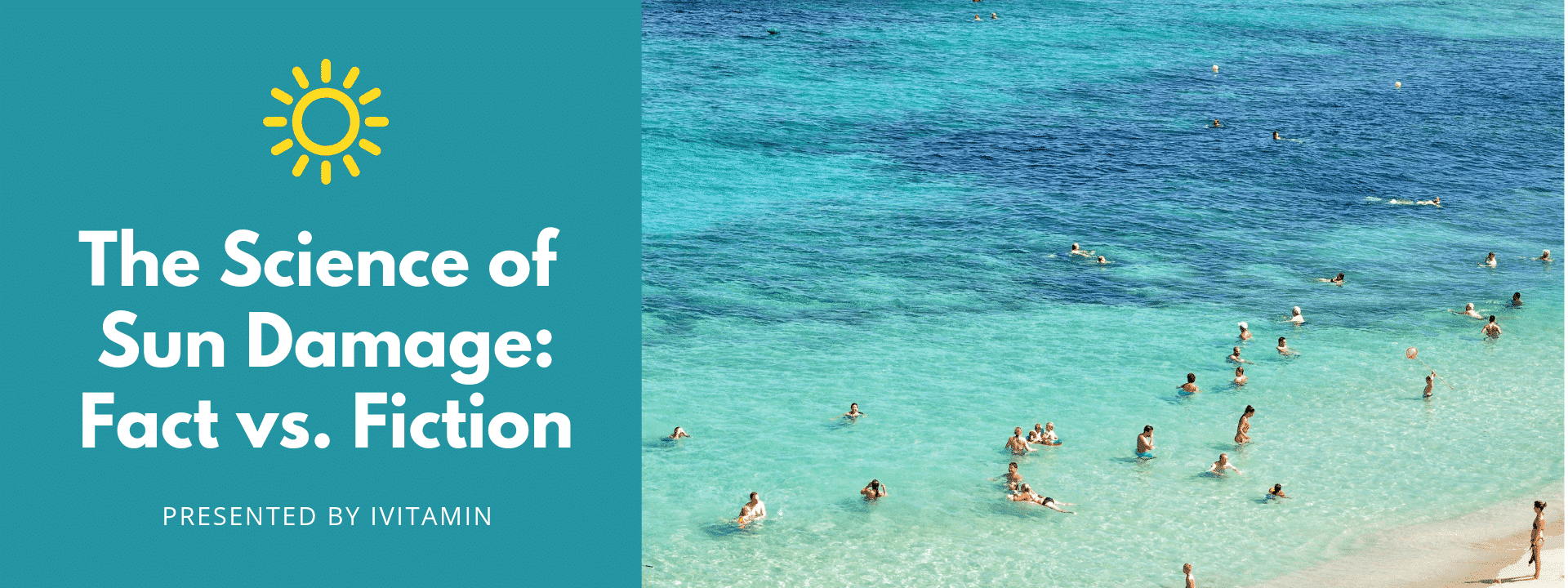Written by Bonnie McLaughlin for IVitamin
I spent Saturday at the beach with my family, Sunday fishing on the boat with my husband, and as y’all can imagine, my poor skin is toast. There is a part of me that operates under the very Jersey-Shore-mentality that everyone looks better with a tan but I know that this sun-slapped look I’m currently rocking comes at a price.
The thing is, we live in Texas and sunshine is a part of the culture. We sip margaritas on patios off South First, do the Barton Springs hop (sit in the sun until you’re hot, jump into the water until you’re cold, lather, rinse, repeat), and train for the Capital 10k in 100+ degree weather. We don’t have time for sun damage but the beauty of the hike and bike trail will ensure that we most certainly are going to encounter it.
According to the American Academy of Dermatology, skin cancer is the most common cancer in the United States, affecting over 3 MILLION PEOPLE per year. And since some of these cases could be avoided with a little preparation and care, it is important that we continue the conversation about how to prevent being a part of this scary statistic.
So let’s dive right in.
Fiction: The higher the SPF, the better the sunscreen.
Fact: Let’s start off with the complicated one. The SPF of a sunscreen is determined by the amount of time it took the test group to burn with the sunscreen divided by the amount of time it took them to burn without it. So let’s say it takes you 10 minutes to burn without sunscreen but 50 minutes with it. With some simple math we see that: 50/10=5 so that sunscreen has an SPF of 5. Now, no one wants to apply sunscreen that often so logically you would buy something with a higher SPF to allow you to swim in the ocean like the fabulous mermaid you are for longer, right? But here’s where it gets tricky. SPF ratings increase the amount of protection they provide, not the length of time they last. So a higher SPF just means a higher level of protection from UV rays, not an extended period between applications.
Advice: Always use SPF 30 or higher, apply 15-30 minutes before you actually head outdoors, and reapply every two hours even if you’re not sweating or in the water. Don’t assume an SPF 50 means you’re off the hook for an entire day.
Fiction: Building a “base tan” will help me avoid sun damage. Similarly, being dark-skinned will protect me from sun damage.
Fact: That glorious tan you get from a few hours near the pool is actually your body’s way of protecting itself. When exposed to UV light, your body accelerates the production of melanin that in turn creates the darker skin color associated with a tan. This doesn’t mean that you are going to sunburn less, in fact, a tan is a sign of damage already being done to your skin. As for the melanin-blessed among us, dark-skinned people are at an even higher risk for skin cancer since changes to their skin may be harder to recognize and diagnose. The Journal of American Academy of Dermatology found that African Americans are more likely to die of melanoma even though they are the least likely to be diagnosed with it.
Advice: EVERYONE APPLY SUNSCREEN EARLY AND OFTEN! There are some great chemical-free brands out there like dermatologist-recommended EltaMD or eco-friendly Sun Bum (anything that’s reef-friendly is going to make the beach bag).
Fiction: Rash guards are for surfers, not normal people on the beach.
Fact: While popularized by surfers to protect their stomachs from their boards, rash guards can also protect your skin from UV damage at a higher rate than sunscreen alone. Rash guards are rated on a UPF (UV Protection Factor) system that tells the consumer how much UV light will pass through the weave of the fabric. Good rash guards should have a 30-50 UPF rating, meaning that only 1 out of 30-50 units of UV light will pass through the fabric. Rash guards are a great idea for anyone outdoors for an extended period of time because the lightweight material is perfect for being active in and out of the water. And let’s be real, don’t we all want to be mistaken for a surfer?
(Personal anecdote: if you have a raging sunburn, slather it in aloe, and then try to wiggle into a rash guard for day 2 of spring break, you will not only get an excellent workout but also rub your sunburn ten painful ways to Sunday. Do not replicate. Wear your rash guard when you’ll be in direct sunlight for any extended period of time, not just afterwards when it’s too late.)
Advice: Great brands like Roxy, Volcom, and O’Neill are created for outdoor enthusiasts so they have higher UPF protections and fabrics that prevent chafing. They’re also super cute. But do your research ahead of time or you’ll be shelling out $100 at a tourist trap. My personal opinion? Everyone should have a rash guard in their beach bag if not just for you, but also for your sweet fair-skinned (but dishonest) friend who says, “oh I never burn” before a day at the Texas Coast.
Fiction: I don’t need to apply sunscreen when I’m sitting in the shade or when it’s cloudy out.
Fact: Unfortunately, 80% of UV rays pass through clouds (dang it clouds you had one job). In addition, UV rays reflected off of snow, water, sand, and sidewalks can burn your skin as severely as direct sunlight (raise your hand if you were legit shocked by that horrendous suntan you had around your ski goggles). Scientists say that the hours of 10-2pm are the worst for sun exposure so do your best to either take breaks when the sun is at its highest, or be sure to cover up and reapply sunscreen. When it comes to protecting your skin, more is better.
Advice: Again, sunscreen needs to be applied early and often. For a list of great (and affordable) sunscreens recommended by dermatologists, check out this link!
Fiction: I have a horrible sunburn so I am going to soak it in a hot bath.
Fact: What in the….OUCH. Who told you that? And do they hate you? You’re literally adding heat to a burn, please don’t do that. To soothe a sunburn, make sure you take some pain relievers (if you can) like advil or aleve, COOL YOUR SKIN with topical treatments like aloe or calamine lotion, sit in a cool bath, and HYDRATE. Also, resist the urge to scrub any peeling skin, it’s literally a wound and needs to be treated as such.
Advice: My favorite topical after-sun treatments are Hawaiian Tropic After Sun Hydration and Burt’s Bees Aloe & Coconut Oil After Sun Soother. Both smell great and feel amazing on poor toasty shoulders.
Final Note: Keep in mind that sun damage doesn’t just manifest into cancer, it also ages us prematurely. The horrid meme of the girl with the crazy dark tan turning into a leather couch? Not so far-fetched minus the upholstery joke. Sun damage can be seen in an increase in fine lines and wrinkles on your skin due to the dehydration that occurs. So while cancer should be on the forefront of your mind, it doesn’t hurt to remember that those hours uncovered in the sun are completely undoing your fabulous skincare routine.
Also, if you haven’t already, look for a foundation or powder with SPF in it. You’ll be protecting that gorgeous mug without even thinking about it.
For more information on the science of sunburns check out the Mayo Clinic’s page here.
JOIN OUR COMMUNITY
Receive tips on wellness and nutrition, healthy food recipes, amazing workouts, events that bring our community together, and special offers directly to your inbox!
Contact & Visit
Hours of Operation
M: 10am-6pm*
Tu-W: 10am-4pm*
Th-Su: 10am-6pm*
* We seat the last patient 15 minutes before close time




